All hail Stephen Brotherstone and Dave Lawrence… the square-eyed Liverpudlian duo who, staggered that nobody had yet written a book about the welter of disturbing TV shows, films and – ahem – ice lollies that traumatised our collective 1970s childhoods, set out to fill the gap. The resulting doorstep-sized tome, Scarred For Life, has become a sales sensation, and a follow-up volume, detailing the Cold War-infused minutiae of their 1980s adolescence, is due in 2020.
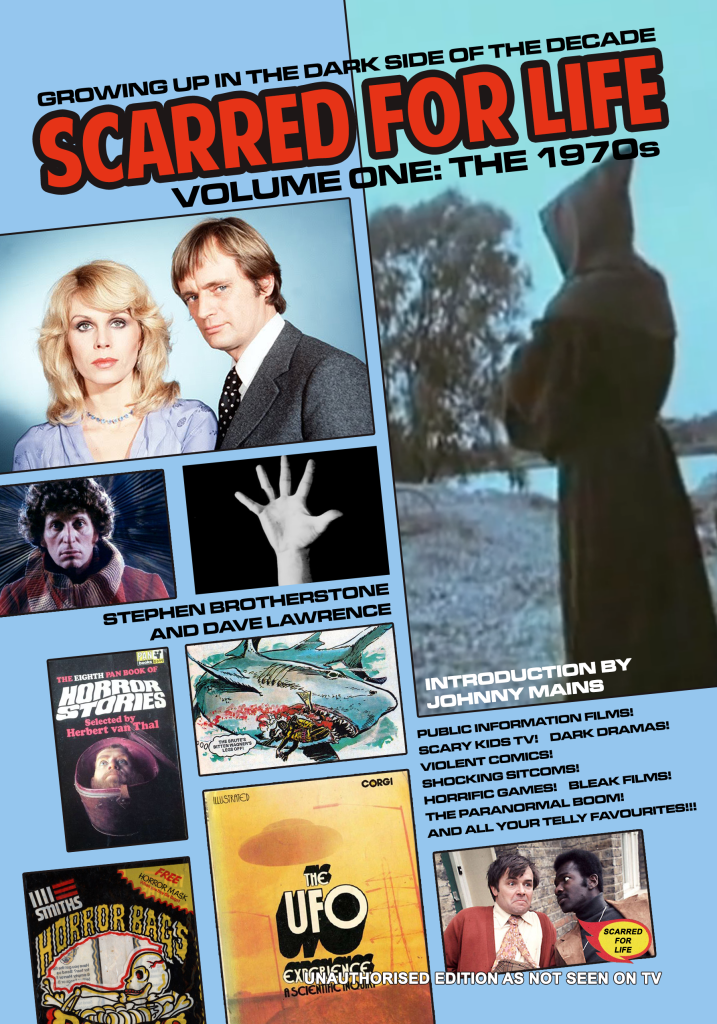
And the book has now inspired a compilation album of original music, all influenced by those lingering memories of childhood disquiet. It includes new tracks by the likes of Vic Mars, The Home Current, Pulselovers, The Heartwood Institute and Polypores, and has been compiled by musician Kev Oyston, who – in his guise as The Soulless Party – also contributes the title track. It’s the start of a busy period for Kev, whose multi-media Black Meadow collaboration with writer Chris Lambert, detailing the dark folk stories of the North York Moors, also sparks back into life in early 2020.
But the Scarred For Life album, released this week by Castles In Space, comes first, with all proceeds heading to Cancer Research UK. It’s a beautiful collection of evocative music, and I asked Kev about the inspiration behind it…
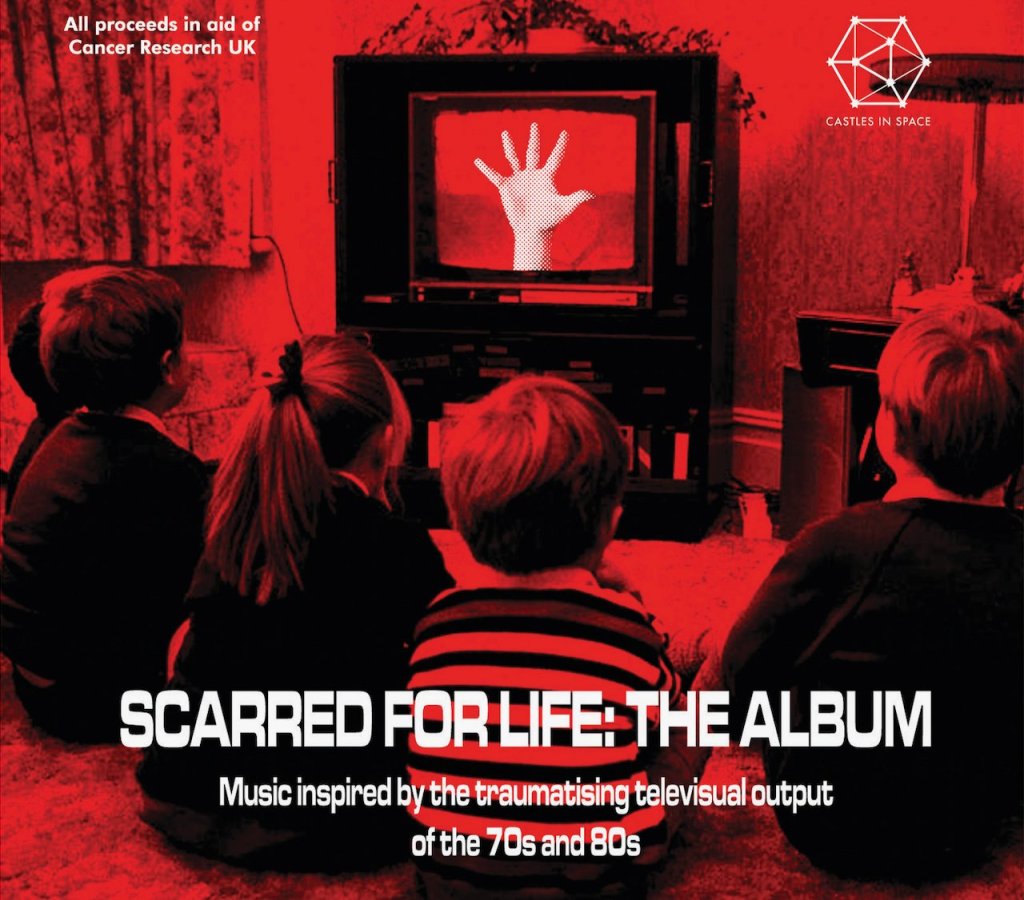
Bob: Where did the idea for the Scarred For Life album come from? I assume you bought the book, and enjoyed it?
Kev: Yeah, I bought the book. It appealed massively to me straight away. Although I was born in 1975, a lot of the early to mid 1970s Public Information Films, schools programmes and children’s programmes were still being re-shown throughout the late 1970s and early 1980s, so a lot of the content of the book rang a big bell with me. I’ve always been fascinated with the dark, weird and ambiguous output of 1970s TV.
Which TV programmes or films from the era really scared you?
My earliest memories are basically from Doctor Who and those Public Information films. Being rather mesmerised by Tom Baker, who himself was pretty scary. I actually remember the reveal of Scaroth at the end of the first episode of City of Death – that absolutely terrified me. I was four! The other Doctor Who cliffhanger that traumatised me was the end of the first episode of Logopolis, where the Master shrunk Aunt Vanessa and the policeman, and left them like lifeless dolls in the car.
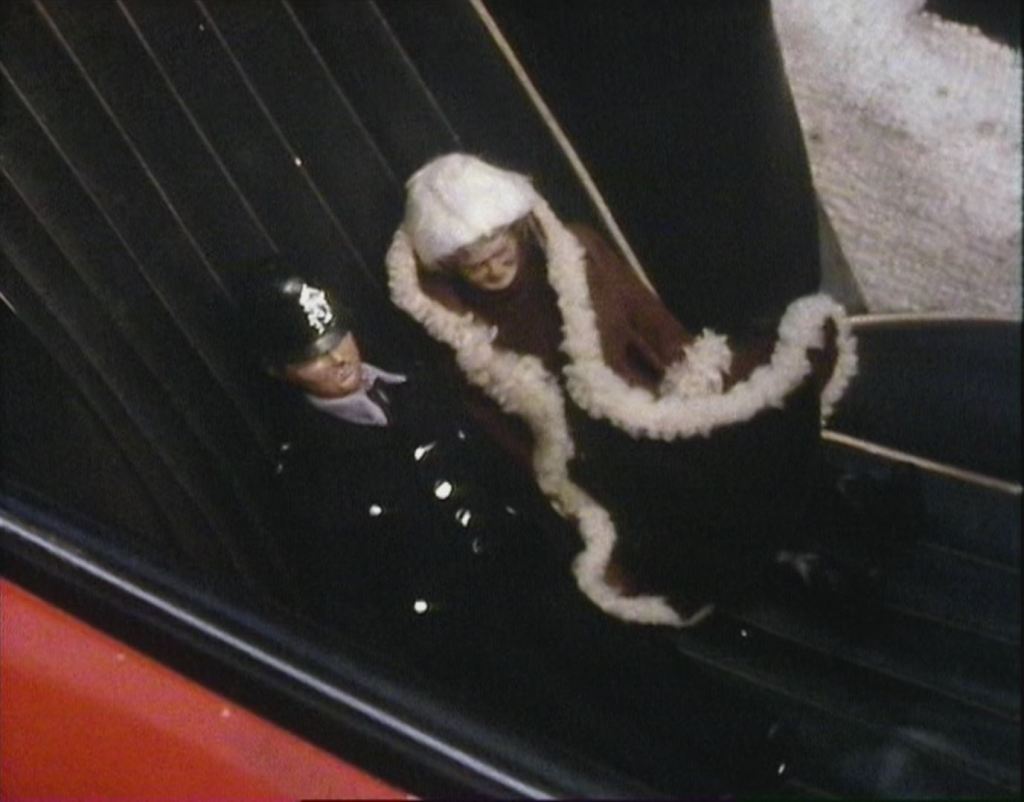
The Public information Films that got to me were the ones with the drivers’ faces being smashed through the car windscreen in very weird slow motion. There was also one with a mother and her little boy, where he runs out into the road and she drops her eggs as he gets run over. I used the think the eggs were the contents of the boy’s head!
And the infamous Apaches, which warned of the dangers of playing on a farm, absolutely gave me nightmares… especially the shot of the boy sinking and drowning in the slurry pit. It was just so lifelike! But that was the idea wasn’t it? To scare you away from doing daft and silly things on roads, or swanning around near farming equipment.
Did other things get to you as well? I found it hilarious that the book’s writers, Stephen and Dave, were scared by “Dracula” ice lollies and “Horror Bags” crisps…
I can remember this quite vividly, and it still gives me chills now… my parents used to threaten me with the rag and bone man, saying he was going to take me away if I didn’t behave. Honestly, that worked a treat because every time I heard him at the bottom of our street shouting, “RAGBONE!!” I’d be off like a shot! In fact I’d hide under my bed!
I think it was his voice, the way he shouted. It was quite snarly and bellowing. I really do still shudder thinking about it.
When, and how, did it strike you to make an accompanying album?
I hit it off with Stephen a long time ago, over our love of the movie Close Encounters of the Third Kind, and we talked on and off for a while about different things. It wasn’t until we actually met, at their first Scarred For Life show in Eaglescliffe about a year ago, that we talked quite excitedly about the idea of doing a compilation album. I found the subject of the book to be really evocative, and thought it would carry the weight of a concept album quite well.
At first we toyed with the idea of doing covers of old 1970s and 80s TV themes, fitting in with the Scarred For Life ethos. But after much pondering and research, I discovered that it would end up being a huge copyright headache, so we parked the idea for a bit.
It wasn’t until I heard that the lads were working on a sequel to the original Scarred for Life book, this time covering the 1980s, that my interest in doing something was piqued again. So I spoke with Stephen and asked what he thought about a compilation album of music “inspired” by the TV and film output of the Scarred for Life era. He loved the idea, so I went away and rallied some artists.
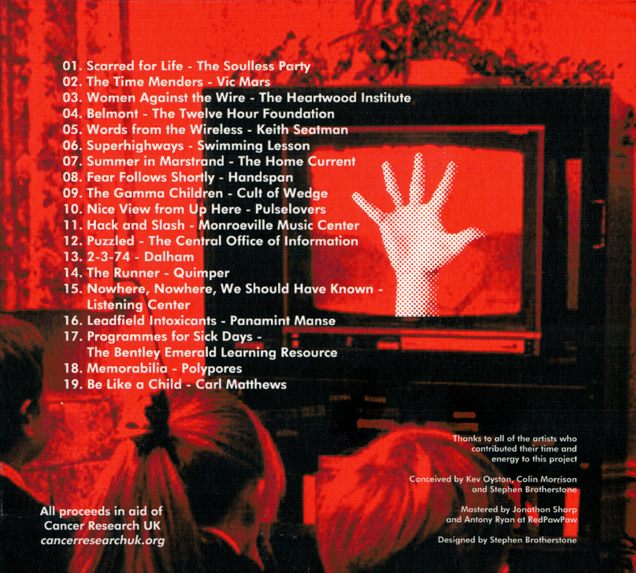
Did you draw up a hit list of you wanted to approach? Are a lot of these artists people that you’ve known for a long time?
It all seems a bit of a blur now, but I think it was quite organic. The first person I approached, more for advice, was Colin Morrison from the Castles in Space label. I already had something on the boil with him, and thought it would be good to run this idea past him too. Before we knew it, he’d signed up to the whole thing, lock stock and barrel, and wanted to promote and push it all! I was absolutely bowled over.
A lot of the artists I approached, I’d known forever… Vic Mars, Monroeville Music Center, Pete Hackett – aka Cult of Wedge – Keith Seatman and Swimming Lesson. They all jumped at the chance to be on the album. I’d always admired the other acts too… The Twelve Hour Foundation, the achingly lovely Jonathan Sharp from The Heartwood Institute, Listening Centre, Rob from Handspan… in fact I admire everyone we have on there!
It was nice, because I proposed the idea to each of these artists, and immediately there was a mutual understanding of the premise, and the important cause that the album was for. Not only that, each individual who took part was just massively likeable, and easy to get along with. I had everyone in a Scarred for Life private group and we all just clicked. Honestly, it was really lovely. Most of the artists were already aware of Stephen and Dave’s wonderful book and were really keen to take part.
What was the remit you gave them all as a starting point for their tracks?
Because the Scarred For Life books are about to hit the 1980s, I gave them the remit of creating music that reminded them of that kind of “off kilter”, not quite right, TV shows or movies that they’d watched as kids in the 1970s and 80s. But not just the TV shows… other things besides.
Can you give us a little rundown the tracks themelves, and the inspirations behind them?
Well, I thought I’d let the artists speak for themselves! I managed to coax this out of them all the other day… here’s what some of them have to say on each of their pieces:
Vic Mars: The Time Menders
Vic Mars: The Time Menders was an early title for Sapphire and Steel, and I was aiming for a psychic paranormal investigator theme.
The Heartwood Institute: Women Against The Wire
Jonathan Sharp: The Heartwood Institute track is a direct reference to the women’s peace camp at Greenham Common, and that’s also where the sample is from: “We are women, we are strong…”
The Twelve Hour Foundation: Belmont
Jez Butler: Our track is named after the TV transmitter near my old home town in Linconshire. Rather than being based on a specific theme tune, it’s a more generic radiophonic-inspired thing, with the focus on the sudden start – in the style of a scary 70s kids’ drama intro – and the the cliff-hanger at the end. If that makes sense!
Keith Seatman: Words From The Wireless
Keith Seatman: Words From The Wireless was inspired by the 1972 series Escape Into Night, and the book that inspired it, Marianne Dreams. “Not the light!”
Swimming Lesson: Superhighways
Darryl Wakelin: Mine was inspired by the excitement and dread – in equal measure – of what computing in the future would be like. A mix of Tomorrow’s World, and the machines that would destroy us, control us or be used for war. Think 2001: A Space Odyssey, Demon Seed, UFO, Space 1999, etc…
The Home Current: Summer In Marstrand
Martin Jensen: Summer in Marstrand is inspired by growing up with the Moomins on Danish TV. I was part fascinated, and part scared senseless, every time an episode aired. Some of my childhood summer holidays were spent on the Swedish island of Marstrand, and apart from it being where I saw my very fist White-Tailed Eagle, I also remember thinking the Moomins could easily have come from there.
Handspan: Fear Follows Shortly
Rob Colling: Mine came mainly from the fact that I’d been listening to Clannad’s Legend, the soundtrack album from Robin of Sherwood, quite a lot in the weeks running up to this project. That’s why so many of the modular synth noises sound a bit like Celtic harps. It actually ended up in more of a Look And Read kind of place, somewhere between Dark Towers and The Boy From Space, hence the track title, but my initial idea was much more about forests and mist and standing stones. And terrifying early digital video effects.
Cult of Wedge: The Gamma Children
Pete Hackett: Originally I’d written an actual song, words and all, but I couldn’t sing it due to the stupid key, and time was running out, and everyone else’s tracks were instrumental… so I recorded a theme tune! It’s pretty much on a theme of The Tomorrow People, but has time travel / indigo / psychic children ideas going on. Hence the kid at the start seeing dead people…
Pulselovers: Nice View From Up Here
Mat Handley: Nice View From Up Here is my take on the theme tune for a sitcom starring Joe and Petunia from the Public Information Film series made between 1968 and 1973. I imagined a particularly un-PC studio comedy in the style of George and Mildred, but with a theme more inspired by the brilliant Ronnie Corbett vehicle, Sorry!
Monroeville Music Center: Hack and Slash
Craig Storm: I sat down trying to make an homage to Knightmare, and instead ended up with what seems like the end credit music to an educational programme’s Halloween episode, if it had spliced in eight-bit voice actor samples from a third-rate medieval adventure game. It’s no Knightmare, but it’s a show I’d like to watch.
The Central Office of Information: Puzzled
Alex Cargill: Puzzled is loosely based on the 1970s and 1980s BBC kids TV show Jigsaw, which featured the infamous character of Noseybonk. Genuinely disturbing for a young child. I tried to imitate the generally upbeat feel of the original, along with the childish sound effects. The laughter snippet is actually a sample of my late Grandad – it seemed to fit nicely and I thought it’d be nice to have him immortalised on a CD. It’s what he would’ve wanted. However, as is often the case, I couldn’t help myself from adding a little bit of acid squelch to the proceedings.
Quimper: The Runner
Johnny Vertigan: I think I was gleefully ripping off the slightly sinister library themes that would sometimes find their way onto Pages from CEEFAX. Or the kind of thing that would be used for either a forgotten, warped 1970s BBC drama, or perhaps a schools’ programme about maths. Same difference back then, I suppose.
Listening Center: Nowhere, Nowhere, We Should Have Known
David Mason: My offering is inspired by the multiple layers of uncanny-ness and the fractured parallel realities reflected in Sapphire and Steel. The title is borrowed from the final episode of the series, where (Spoiler Alert!) Sapphire and Steel find themselves trapped in a cafe, in the void, for eternity.
Panamint Manse: Leadfield Intoxicants
WP Ulmer: I was channelling Harry Forbes watching The Finishing Line…
The Bentley Emerald Learning Resource: Programmes For Sick Days
Benjamin Green: Programmes for Sick Days takes inspiration from “Programmes for Schools”, generally the only television available to watch for children who were too poorly to go to school that day. Quite dry programmes that perhaps seemed dead boring in a classroom would become extraordinarily fascinating and eerie in the cosy setting of the living room. My track tries to evoke the images and sounds of a morning of school programming, through the woozy haze of feeling unwell. Dosed up on children’s medicine, and safely bundled up within blankets and quilts to make a bed on the settee.
To temper the cosiness, I will add that while experiencing a proper bout of influenza for the first time as a child, I had a morbid thought during an episode of Zig Zag that I might end my days on the sofa, and these would be the last visuals and sounds I’d ever experience. And I’ve since often wondered if, for some poor souls, that may have been the case….
Polypores: Memorabilia
Stephen J Buckley: My track, as with most of my music, wasn’t really planned or thought out as such. It’s not really up to me what I write on any given day. I simply made myself available, open to suggestion, and coaxed it from the strange ether from which music comes. Basically, I was led down a Scarred for Life ether vortex, and the track just came out!
And Kev, your own theme music, the opening track to the album?
Yes, it was the main Scarred for Life theme that I tasked myself with, and I just wanted to encompass sounds and layers that echoed the likes of Denton and Cooke, and Peter Howell… with a cheeky nod to John Carpenter, too.
What’s your own background as a musician? Can you give us a little potted history, please?
I was massively into music from a very young age. I used to spend a lot of time round at my cousins’ house, and they were quite big into electronica, post-punk and ska. I was basically a sponge, and I loved everything they listened to. They had a loft conversion with lots of old synths in it, and wrote their own material as well as doing cover versions for a college band they were in. Again, I was hooked. By the age of 12 I had my first synthesizer, a Korg Poly 800. I also had a four-track tape recorder to lay down any ideas I had. I got a few more synths in my twenties, and chucked out a few demos of instrumental tracks to various people. One of whom told me that I’d be good for TV adverts or soundtrack work… however, being very young, idealistic and quite naive, I was quite put out by this! I went off to form a synth-pop band with my cousin, Rob.
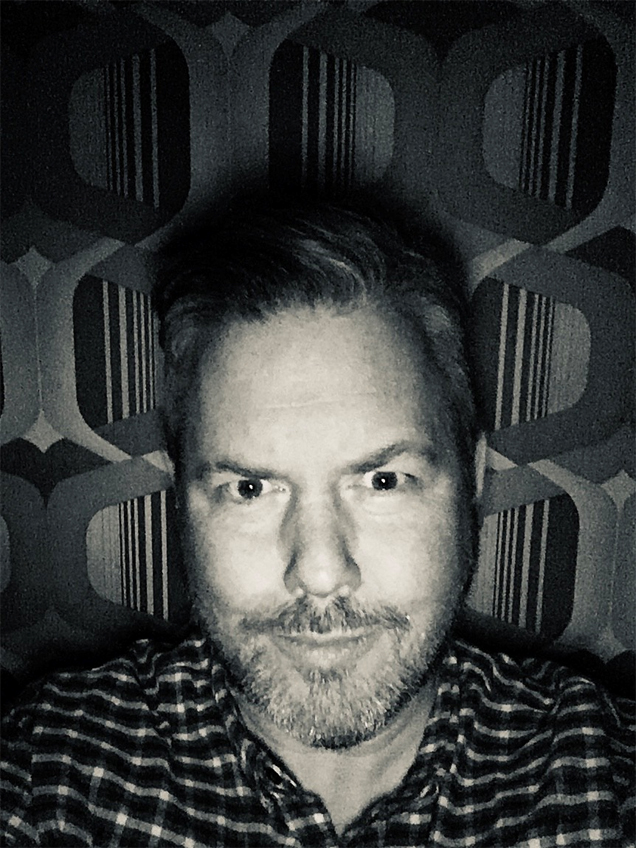
I wrote all the tracks and did some of the vocals and we set out round London gigging on the – then – underground electronic music circuit for a few years. We had a nice little following, and released an album… which maybe ten people might have in their collection.
As the years progressed, I started getting into Ghost Box Records. Their output totally blew my mind and took me back to my childhood in very strange ways… to the classroom, or to a cornfield or a forest on a warm, hazy day. I just loved what I was hearing. That inspired me to go down a similar instrumental route, trying to come up with something that reminded people of the past. New music that sounded like vintage music. I think I achieved that with the Black Meadow project.
I was going to ask about the Black Meadow project. Can you tell us a little bit about this?
While I was trying to find that sound of the past, I wrote a track which I just randomly called Beyond the Moor. It ended up on the Tales from the Black Meadow album, but at the time I wrote it, I had no idea what it could be for… why did I call it Beyond the Moor? But the more tracks I wrote with a similar vibe, the more it organically fell into place. The concept came to me.
As a child, we used to drive regularly over the North York Moors to Pickering, to see relatives. We’d always pass the three huge, golf ball-like radomes that belonged to RAF Fylingdales, and – being a kid with his head in the clouds – I always imagined strange alien craft being housed there. Or something akin to Quatermass, that kind of thing. My imagination ran wild. I recalled all that as I wrote the music for the first Black Meadow album and it just gave me the impetus to keep going. I had an idea of a story, or of strange folklore, attached to this place called The Black Meadow, which was slap bang right next to RAF Fylingdales. It was to be a place of mysterious fog, creatures and a Brigadoon-type village that appeared only under certain atmospheric conditions. The village is full of weird monsters and people, and is just downright creepy.
My old partner in crime Chris Lambert took an interest in this project and my ideas, and basically wanted to put them all into proper folklore-style stories, and have them published along with the album. I got carried away with the idea, and pushed for something else to go alongside the music and the book, and that was… why don’t we “dig up” an old BBC Radio 4 documentary from 1978, all about the Black Meadow, and add it to the album? So we did.

The original Tales from the Black Meadow CD – with the music and the documentary – was released in 2013, along with the book. The book still sells well today, and sometimes I re-release the album and it always seems to do OK.
And there’s some new material coming in January 2020?
It’s taken a long time, but we’ve just completed the second Black Meadow project, The Black Meadow Archive: Vol 1. Again, it’s an album of music, this time on vinyl, again on the lovely Castles in Space label. And there’s also a new, jam-packed book too. We’re quite excited to release it to the world. We just hope everyone likes it!
In the meantime, Scarred For Life is out this week, and all proceeds are going to Cancer Research UK… is it a cause that’s dear to your heart?
Absolutely. Sadly, someone very close to me was diagnosed with cancer in May and it’s been a very tough few months. Happily things are looking positive, as the treatment has done the job, and we’re hoping everything will be clear come the New Year.
Its funny how you can appreciate, yet still take for granted, some of the work these charities do. It’s not really until something affects you close to home that you start to really appreciate their work. Cancer Research UK are a hugely proactive concern… they’re a positive power for good in the search for a cure to cancer, and they provide fantastic support to those who may be suffering. They were the first charity I thought of when we were putting this album together, and it’s been brilliant to see people buying the album also getting behind the charity too.
Thanks to Kev for his time, and thoughtful replies… and to everyone else on the album for contributing, too. The Scarred For Life album is available here…
https://scarredforlife.bandcamp.com
…and it concludes on a poignant note; the closing track, Be Like A Child by Carl Matthews, is a genuine piece of beautifully melancholy 1984 electronica from an artist whose own life was cut tragically short by cancer. It’s a fitting conclusion to a wonderful collection of music.
I asked Jonathan Sharp, of The Heartwood Institute, about his memories of Carl. He replied…
“Carl is one of the great lost voices of UK synth. He started releasing cassettes from 1980 via the Mirage label – all very DIY – and continued up to 1991. You can find a big list of his output on Discogs. He was incredibly well-respected, but largely unknown. I got to know Carl around 2001 when he started making music again, and we became good friends. I encouraged him into making library, music at which he became very successful. More recently, there’d been a real interest in his old music, and he’d had Call For World Saviours released on CD and vinyl, and had appeared on several high-profile compilations too. He’d also started releasing new music via bandcamp. Sadly he died a few months ago, just as the Scarred For Life compilation was coming together. As soon as I knew it was raising money for Cancer Research UK, it seemed natural to have a track of his on the album. His family agreed, and it’s so lovely to have that track on there.”
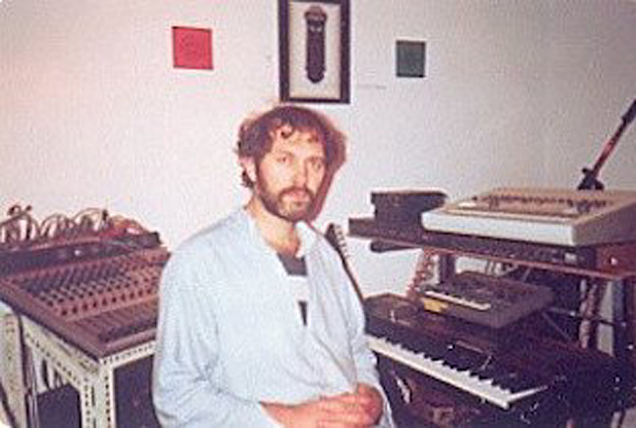
2 thoughts on “Scarred For Life, Kev Oyston and Memories of 1970s TV”